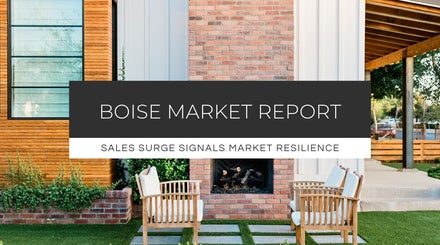
Boise-area homebuyers have slightly more room to breathe as we transition into fall, thanks to a small influx of inventory in August, coupled with a bit less demand for housing. But don’t breathe too deeply – this isn’t to say that the market is balanced. It’s still very much a seller’s market and will likely remain that way for the foreseeable future, for reasons we’ll outline below.
But first, let’s dive into last month’s data. The median single-family house price in Ada County was $530,500 in August, which represents a 33% increase (or $130,000) from a year ago. While the median home price slightly declined from the month prior – marking the first price decrease we’ve seen since May of 2020 – it’s still the second-highest price on record for the county.
Canyon County’s median house price rose to $410,500 in August, a $100,000 or 32% jump over last year. Like Ada, home prices in this county are down slightly from June’s record high, but still remain at their third-highest point.
Here’s a closer look at a few of our local markets:
- Boise hit a new record of $510,000 for its single-family median home price. That’s a 34% increase from last year.
- Meridian’s median home price this month held steady from July at $539,990 – also a 34% year-over-year increase.
- With a home price of $405,000 in August, Nampa prices have risen nearly 30% over the last year.
- Finally, the Treasure Valley’s highest valued housing market, Eagle, crossed the $900,000 mark for the first time, hitting a new record of $907,321. Since last year, median home prices in the exclusive community have risen 51%.
Late July also marks a shift in the type of homebuyers we typically see, with fewer families with kids looking to buy now that school’s starting up, and more individual buyers (or families without children at home). These buyers tend to prefer houses that are smaller and easier to maintain, which often means newer homes with easy upkeep.
That shift in the types of homes being sold helps explain one trend we saw in August: while median home prices were lower than the previous month, both county’s price per square footage was actually higher.
We mentioned a dip in demand in the Treasure Valley market – it’s there, but it’s slight. We’re talking 2020-molten-magma hot versus five-alarm-fire hot, which is where we’re currently at. For example, median-priced homes are selling for $5,000-$8,000 more than asking, and many new listings continue to receive multiple offers. Across the valley, houses spend a median of 7-8 days on the market, the lowest for any August on record.
Demand Is Strongest for Entry-Level and Luxury Homes
As we predicted in July, supply increased over the summer. One reason for that was higher prices spurred more sellers to list their homes – especially those who put off selling at the beginning of the pandemic. In addition, seasonal patterns we see most years (2020 excluded) have nudged inventory higher.
On the flip side, buyers have become discouraged by the reduced affordability and the break-neck speed that homes are selling – both of which have helped dampen demand. But it's all relative – there is still fierce competition among buyers in the valley, particularly at the 'ends' of the market.
Demand continues to be very strong at entry-level price points (i.e. under $400,000), where most first-time homebuyers and investors are looking. Luxury homes are also getting snapped up quickly. New construction supply disruptions, coupled with increased demand for luxury homes, have helped push these home prices even higher this year. In fact, sales of homes priced above $1 million have nearly tripled in the first eight months of this year when compared to the same period last year.
What’s languishing on the market? Pricey fixer-uppers. Older properties that need significant remodeling or have deferred maintenance are simply not in demand, especially with hefty price tags attached. Buyers have little appetite for taking on big projects right now – when finding a contractor to upgrade or remodel a home is a fight in and of itself.
Treasure Valley Inventory Grows, But Not Enough To Dampen Prices
Inventory in Ada County grew to 1.23 months (or about five weeks) of supply in August, whereas last August we were hovering around three weeks. At our lowest point, in March of this year, we were down to about one week of inventory – meaning if no new homes came on the market during that week, the entire county’s supply of homes for sale would be depleted.
Canyon County’s active inventory also grew to about six week’s supply of inventory last month, compared to just two weeks’ of supply last year.
Many factors influence housing supply and demand, but when it comes to market statistics, months of supply is the single best predictor of price changes.
As a reminder, a balanced market is about five months’ worth of inventory. In general, anything above a six-month supply usually leads to lower prices, while anything below a five-month supply leads to rising prices. Being at 1.23 months of supply signals double-digit near-term price appreciation.
During the financial crisis, prices didn’t top out until supply rose to five months – and then they flattened out for more than a year while inventory surged. Prices finally began dropping when supply hit around eight months.
National Home Prices Show 19% Gains
What we’re seeing locally is playing out across the U.S. As Reuter’s reports, the widely regarded S&P CoreLogic Case-Shiller composite index shows that from June of last year to this year, single-family home prices rose 19.1%, the fastest pace on record for 20 key metropolitan areas.
Comparing the 2007-2009 period in the housing market to today, the article makes a key distinction. Home prices have risen in 2021 “as a result of limited supply and increased demand from potential buyers” versus “a frenzy of speculators and buyers with low credit scores purchasing homes and trying to flip them." In other words, prices are rising due to real demand from homeowners, not speculative frenzy.
Low Mortgage Rates Are Keeping People in Their Homes (and Their Homes off the Market)
As you’re probably aware, mortgage rates plunged when COVID-19 hit the U.S. as a result of decisions made by the Federal Reserve to try and stimulate economic growth. Over the past year, for this same reason, rates have drifted lower. For the week ending on Sept. 2 they averaged 2.87% for a 30-year fixed loan. This percentage is only slightly above all-time lows.
Low mortgage rates make homes more affordable – thereby increasing demand. But lower rates can also limit supply. In Ada County, there were 1,027 homes sold in July. In comparison, there were 1,425 refinance transactions, which included homeowners paying off a higher-priced mortgage and in some cases, pulling equity out of their homes to pay for everything from home remodels to vacations.
In other words, we’re seeing homeowners lower their monthly mortgage payment (while potentially lining their pockets), which is an incredibly strong incentive to stay put. This is just one more reason supply remains constrained.
Boise Real Estate Market Summary for August 2021
- Median list price - $502,500 (up 34.04%)
- Median sold price - $510,000 (up 34.25%)
- Price per square foot - $311 (up 38.2%)
- Total home sales - 418 (down 75)
- Median days on market - 7 days (up 1 day)
- Available homes for sale - 1.11 month supply (up 0.42)
- 30-year mortgage rates - 2.84% (down 0.10)
Boise Metro Housing Markets by Area
Median sales price:
- Ada County - $530,500
- Eagle - $907,321
- Garden City - $500,000
- Kuna - $467,495
- Meridian - $539,990
- Star - $500,000
- Canyon County - $410,500
- Caldwell - $394,000
- Middleton - $429,000
- Nampa - $405,000
More From Our Blog
Information in this We Know Boise market report was obtained from the Intermountain MLS (IMLS) between September 3rd-8th, 2021. Deemed reliable but not guaranteed. City data refers to single-family homes on less than one acre, while county data includes homesites of all sizes. Current inventory is calculated on a twelve-month rolling average. Combining existing homes for sale with new construction is the best way to gauge current home prices and Boise housing market trends. New house prices are much more volatile and can create unreliable comparisons, particularly on a month to month basis.
Posted by Lisa Kohl on






Leave A Comment